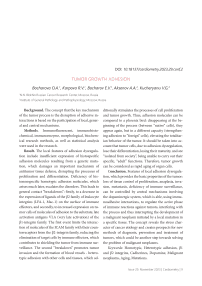Tumor growth adhesion
Автор: Bocharova O.A., Karpova R.V., Bocharov E.V., Aksenov A.A., Kucheryanu V.G.
Журнал: Cardiometry @cardiometry
Рубрика: Conference proceedings
Статья в выпуске: 29, 2023 года.
Бесплатный доступ
Background. The concept that the key mechanism of the tumor process is the disruption of adhesive interactions is based on the participation of local, general and central mechanisms.
Homotypic, heterotypic adhesion, β1 β2 integrins, cadherines, dopamine, malignant neoplasms, aging
Короткий адрес: https://sciup.org/148327404
IDR: 148327404 | DOI: 10.18137/cardiometry.2023.29.conf.2
Текст статьи Tumor growth adhesion
-
1N.N. Blokhin Russian Cancer Research Center, Moscow, Russia
-
2Institute of General Pathology and Pathophysiology, Moscow, Russia
Background. The concept that the key mechanism of the tumor process is the disruption of adhesive interactions is based on the participation of local, general and central mechanisms.
Methods . Immunofluorescent, immunohistochemical, immunoenzyme, morphological, biochemical research methods, as well as statistical analysis were used in the research.
Result. The local features of adhesion dysregula-tion include insufficient expression of histospecific adhesion molecules resulting from a genetic mutation, which damages an important mechanism of antitumor tissue defense, disrupting the processes of proliferation and differentiation. Deficiency of his-tononspecific homotypic adhesion molecules, which arises much later, escalates the disorders. This leads to general contact “breakdowns”: firstly, to a decrease in the expression of ligands of the β2 family of leukocyte integrins (LFA-1, Mac-1) on the surface of immune effectors, and secondly, to increased expression on tumor cells of molecules of adhesion to the substrate, late activation antigens VLA (very late activation) of the β1-integrin family. The first event limits the interaction of molecules of the ICAM family with their counterreceptors from the β2-integrin family, reducing the elimination of target cells by immune effectors, which contributes to shielding the tumor from immune surveillance. The second “breakdown” promotes tumor invasion and the formation of blood vessels - heterotypic adhesion with other cells and tissues, which ad- ditionally stimulates the processes of cell proliferation and tumor growth. Thus, adhesion molecules can be compared to a phoenix bird: disappearing at the beginning of the process (between “native” cells), they appear again, but in a different capacity (strengthening adhesion to “foreign” cells), elevating the totalitarian behavior of the tumor. It should be taken into account that tumor cells, due to adhesion dysregulation, lose their differentiation, losing their maturity, and are “isolated from society”, being unable to carry out their specific, “adult” functions. Therefore, tumor growth can be considered as rapid aging of organ cells.
С onclusion. Features of local adhesion dysregula-tion, which provides the basic properties of the tumor: loss of tissue control of proliferation, anaplasia, invasion, metastasis, deficiency of immune surveillance, can be controlled by central mechanisms involving the dopaminergic system, which is able, using immunoadhesive interactions, to regulate the active phase of immune reactions against tumors, interfering with the process and thus interrupting the development of a malignant neoplasm initiated by a local mutation in a specific tissue. The concept reveals the stress character of cancer etiology and creates prospects for new methods of diagnosis, prevention and treatment of tumors, which could be another step towards solving the problem of malignant neoplasms.


